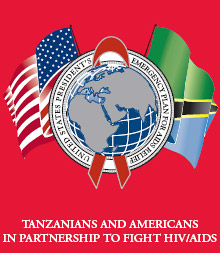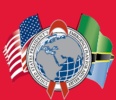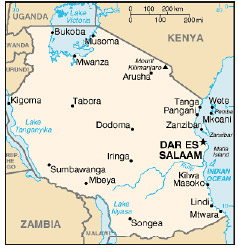| 2008 Country Profile: Tanzania PDF version PDF version

 |
|
2008 Country Profile: Tanzania
National HIV prevalence rate among adults (ages 15-49): 6.5 percent1
Adults and children (0-49) living with HIV at the end of 2005: 1.4 million1
AIDS deaths (adults and children) in 2005: 140,0001
AIDS orphans at the end of 2005: 1.1 million1
Tanzania is one of the Emergency Plan’s 15 focus countries, which collectively represent approximately 50 percent of HIV infections worldwide. Under the Emergency Plan, Tanzania received more than $70.7 million in Fiscal Year (FY) 2004, nearly $108.8 million in FY 2005, $130 million in FY 2006, and approximately $205.5 million in FY 2007 to support comprehensive HIV/AIDS prevention, treatment and care programs. In FY 2008, PEPFAR plans to provide approximately $303 million.
|
|
| Recognizing the global HIV/AIDS pandemic as one of the greatest health challenges of our time, President George W. Bush announced the President’s Emergency Plan for AIDS Relief (Emergency Plan/PEPFAR) in 2003 — the largest international health initiative in history by one nation to address a single disease. The United States is changing the paradigm for development, rejecting the fl awed “donorrecipient” mentality and replacing it with an ethic of true partnership. These partnerships are having a global impact and transforming the face of our world today.
Partnership to Fight HIV/AIDS
The U.S. Government (USG) strategy builds on existing structures and plans, working in concert with the Government of Tanzania and other donors. Tanzania’s development of a national policy on HIV/AIDS marked a milestone in its response to the epidemic. This effort was reinforced by concurrent establishment of a high level, multi-sectoral commission in the Prime Minister’s office (the Tanzanian Commission on AIDS or TACAIDS). On the mainland, TACAIDS is the strategic leader and coordinator. The Zanzibar AIDS Commission is responsible for overall leadership and coordination of the response on the islands.
The USG is an active member of a major multilateral and bilateral support coordination group: the Development Partner Group, HIV/AIDS subgroup. The aim of the group is to enhance commitment and coordination among international partners’ efforts to support the accelerated national response to HIV/AIDS.
The USG response in Tanzania focuses on several core themes, including:
- Valuing and utilizing the strengths of all partners;
- Improving service delivery, including policy formulation;
- Building human and institutional capacity; and <>LI>Implementing the “Three Ones” – one national AIDS strategy, one national AIDS coordinating authority, and one agreed upon national AIDS monitoring and evaluation system.
|
| Emergency Plan Results in Tanzania |
| # of individuals receiving antiretroviral treatment as of September 30, 20071 |
|
96,700 |
| # of HIV-positive individuals who received care and support in FY2007 (including TB/HIV)1 |
|
274,100 |
| # of orphans and vulnerable children (OVCs) who were served by an OVC program in FY20071 |
|
471,300 |
| # of pregnant women receiving HIV counseling and testing services for PMTCT since the beginning of the Emergency Plan1,2 |
|
1,119,500 |
| # of HIV-positive pregnant women receiving antiretroviral prophylaxis for PMTCT since the beginning of the Emergency Plan1,3 |
|
47,600 |
| # of counseling and testing encounters (in settings other than PMTCT) in FY20071 |
|
1,349,200 |
| # of individuals reached with community outreach HIV/AIDS prevention programs that promote Abstinence and/or Being Faithful in FY2007 |
|
2,698,400 |
| # of individuals reached with community outreach HIV/AIDS prevention activities that promote Condoms and related prevention services in FY2007 |
|
3,059,600 |
| # of USG condoms shipped from Calendar Year 2004 to 2007 |
|
56,337,000 |
Note: Numbers may be adjusted as attribution criteria and reporting systems are refined. Numbers above 100 are rounded to nearest 100.
1 Total results combine individuals reached through downstream and upstream support.
2 It is possible that some individuals were counseled and tested more than once.
3 It is possible that some pregnant women received antiretroviral prophylaxis more than once over the two-year period, e.g. HIV positive women who were pregnant more than once. |
 |
Emergency Plan Achievements in Tanzania to Date |
|
HIV/AIDS in Tanzania
Tanzania faces a mature, generalized HIV epidemic. Among the 1.4 million people living with HIV/AIDS, 70.5 percent are 25 to 49 years old, and 15 percent are 15-24 years. In young women ages 15 to 24, there is an HIV prevalence rate of 3.8 percent, which is significantly higher than the 2.8 percent prevalence rate among young men in the same age group.1 Other populations at high risk for HIV infection include people in prostitution, miners, police officers, prisoners, people in the transport sector, and the military.2 Like other countries in East Africa, the epidemic in Tanzania has remained stable in recent years, but there has been a recent increase in HIV prevalence among older age groups, with the HIV prevalence rate among women ages 30 to 34 reaching 13 percent.1 Injecting drug use is also increasing, highlighting the need for improving prevention efforts and expanding access to treatment and care.
Challenges to Emergency Plan Implementation
The greatest challenge facing the health sector is inadequate human resources to deliver quality
|
|
 |
| health services to the Tanzanian population. Since the 1990s, structural adjustment policies and HIV/AIDS have greatly reduced the health-sector workforce.1 A second challenge is poverty, important because the cost of drugs and health services has constituted a financial barrier to access.2 Tanzania has formulated its second “Poverty Reduction Strategy” paper to reinforce its commitment to overcoming poverty. Tanzania also continues to struggle with the issue of corruption, with the health care sector being ranked as the second most corrupt sector in the country by the country’s Economic and Social Research Foundation. Due in part to the vast size of the country, health services do not currently meet acceptable quality standards, and access to voluntary counseling and testing services varies greatly.2 Overall, while services may be available, the human and physical infrastructure is in need of improvement to allow for better quality patient care.
Critical PEPFAR Interventions for HIV/AIDS Prevention:
- Expanded the number of USG-supported service outlets providing a minimum package of prevention of mother-to-child HIV transmission (PMTCT) services from 100 in FY2004 to 699 in FY2007.
- Leveraged non-governmental organizations and other local partners to reach young people with messages on abstinence and faithfulness, and trained or retrained more than 12,800 individuals to provide HIV/AIDS prevention activities that promote abstinence and/or being faithful in FY2007.
- Launched and supported a new condom targeted at high-risk populations and non-traditional outlets. In its first seven months, sales averaged one million per month.
- In 12 out of 21 regions, supported the establishment of blood donor clubs for youth, which ensure a pool of reliable repeat voluntary blood donors under the national blood safety program.
Critical PEPFAR Interventions for HIV/AIDS Treatment:
- Expanded the number of USG-supported sites providing antiretroviral treatment (ART) to 158, and trained or retrained, according to national and/or international standards, 2,800 health workers in the provision of ART in FY2007.
- Supported the strengthening of logistical systems for the distribution of medications and improved drug availability through the implementation of a “pull” system where supplies are replenished on demand.
- Supported adoption of a logistics management information system that provides the capability to order online, reducing lead-time and the potential for transcription errors inherent in a manual system.
Critical PEPFAR Interventions for HIV/AIDS Care:
- Supported treatment for tuberculosis for 6,200 HIV-infected clients attending HIV care and treatment services.
- Supported the work at the national level of five partner organizations to develop policies to expand services through opt-out HIV testing and the use of lay counselors; improve logistics for test kit procurement; and monitoring for quality assurance and national reporting.
- Supported services for orphans and vulnerable children in more than half of Tanzania’s 132 districts, including more than 50 districts benefiting from direct PEPFAR support. Critical interventions include the implementation of the National Plan of Action for Most Vulnerable Children, and the formation of a National Steering Committee and a technical working group on orphans and vulnerable children.
1 UNAIDS, Report on the Global AIDS Epidemic, 2006.
2 WHO, Summary Country Profile on HIV/AIDS Treatment Scale-up – Tanzania, 2005. |
| |  |  |




 PDF version
PDF version